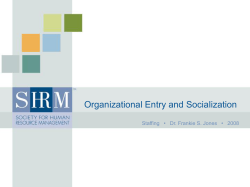
this Article
ISSN 2312-8429 European Journal of Social Sciences Education and Research January-April 2015 Vol.3, Nr. 2 School Dropout and Socialization Prof. As. Dr. Florinda Tarusha ftarusha@yahoo.com Faculty of Educational Sciences, “Aleksander Xhuvani” University, Dr. Ornela Bilali ornelabilali@gmail.com Faculty of Educational Sciences, “Aleksander Xhuvani” University, Abstract This research aims to contextualize, understand and deeply analyze school phenomenon and its effects in life and children socializing. The research aims to find out how children understand school dropout, how they interpret situations and which their perspectives for school and socializing are. Based on initial analyses for actual researches for school dropout in other places, it is noticed that most researches have been correlative and long-tongued; some of them have been assertive programs to prevent school dropout. These researches experiences are new for Albania. At the same time, it has been analyzed Albanian researches that are done by foreign and local organizations and it has been noticed that these researches do not go deep to the correlative factors, causes and long term influence of school dropout. On the other hand, at actual researches, it is studied only present factors for school dropout phenomenon, but it is not studied long terms factors for example: influence on socializing, kind of job, employment. All in all, this research is based on a holistic perspective of the phenomenon. The Research methodology used in the study is a qualitative research and it is based on these methods of collecting information: case study; interview; focus group; analysis of documents and materials in the field. There have been five crucial elements in research realizing procedure: Specifying research subjects; determining the sample; choosing instruments; creating the implementation plan; interpreting research findings; To gather information for school dropout and its dimensions, it has been identified pupils’ group and interest group located in Elbasan district. Keywords: School Dropout, Socialization Research methodology It is a qualitative research and it is based on these methods of collecting information: 1. case study 2. interview 3. focus group 4. analysis of documents and materials in the field There have been five crucial elements in research realizing procedure: 1. specifying research subjects 2. determining the sample 3. choosing instruments 4. creating the implementation plan 5. interpreting research findings To gather information for school dropout and its dimensions, it has been identified pupils’ group and interest group located in Elbasan district. Today’s social structure requires more flexibility and courage. The traditional models of life have always required that the individual planed his life by himself. The legal and social conditions are imprinted in the normal traditional biography. As a 101 ISSN 2312-8429 European Journal of Social Sciences Education and Research January-April 2015 Vol.3, Nr. 2 result, there are cases when people who do not want to follow these previously given models, might fall in the “trap” of the social settings and be shaped by their outside influence1. During the development process, the youth earn the ability for self-determination, but with the growth of responsibility for themselves there is an increase in the risk of failing in : school, job search, education, private life, etc. This risk of failure is carried equally by the adults and the youth. However, it is more difficult for the young people because they do not have well-established models yet. During this difficult stage of their life the youth have to make numerous decisions, which are crucial for their course of life. Behavior and social attitude are crucial at this stage of life. The socialization theory provides a good explanation of this development overview. To make the point more transparent, and to treat the problem of school drop-out and how it effects the course of life of these young people, we have used this theory, which has contributed immensely in this field. Exclusion of the school dropouts from the normal course of life Youth, who cannot finish school are seen as people “without potential” for the work market. These individuals are distanced from the normal life course because cannot fulfill life’s requirements. They are characterized and attributed with “uncertainty”, while the others who fulfill today’s requirements, are attributed with “perspective”. In modern days, failure is interpreted as disuse of possibilities, while the inequality of the conditions is ignored. It is through a widely used evaluation, seemingly objective, that the successful individuals are distinguished by the unsuccsesful making it acceptable for a group to be privileged and the other discriminated. A deviation from the normal means deviation from the structures of knowledge and formal regulations defined by the educational institutions, as a result of social behaviors stereotyping. During the transition from school to work, the dropouts have fewer possibilities to be accepted later in a regular education. The lack of school completion is seen as a sign of incapability in the dropouts. This causes their stigmatization, and as a result, they are excluded from the social integration. Due to this, they have to try harder to approach the normal course of life. But, due to the continuous unemployment and exclusion from the job market, the normal course of life for many young people remains unachievable2. The collective definition of the stages of life is based on educational standards and the normative expectations of behavior. If these standards are not accomplished, then there is a rise of uncertainty and lack of biographical perspective. To avoid failures and the obstacles that arise from them, it is imperative to develop action competencies and personality strength, which are provided in the socialization framework. 1. The theory of socialization Socialization is the process of formation and development of personality in a mutual dependence with the social and material environment. The individual is continuously developed under the influence of the social factors and during social interaction. “The personality of an individual cannot develop outside the society, but in a concrete, living environment, which has historically evolved.3” The theory of socialization tries to explain how a young person, through a productive interaction of the physical and psychological conditions, and the surrounding environment, is transformed in an individual capable to act in a social manner. Hurrelmann, K. (2003). Der entstrukturierte Lebenslauf. p.119 Solga, H.(2003) Ein Leben ohne Schulabschluss. p.547 3 ibid, p.82 1 2 102 ISSN 2312-8429 European Journal of Social Sciences Education and Research January-April 2015 Vol.3, Nr. 2 1.1 The effect of social environments in the process of socialization As an external reality, our social structure shapes to a great extend the social and material conditions of our life. All the members of society are in contact with the social organizations and the economic, political, religious, and cultural institutions. This confrontation influences the development of the individual’s personality. Year after year there is a higher participation of the population in the public and organized environments of socialization, like: kindergartens, schools, education institutions and high schools. The most important educational institution (as well as the socializing institution) is, and will always be, the family. Even though its values have changed in time, considering its intensity and duration, it is the most important institution of education. 1.2 A structural model of the socialization conditions The institutions of educations are intertwined with the other social institutions. It is difficult to evaluate the importance of an institution of education. They are an integral part of each other, complement each other and function together. In the structural model presented below are included all the social institutions, which are very important for the process of socializing. Fig. no 1. The model of the socializing conditions structure1 1 Cited by Hurrelmann, K. (1993) Einfuhrung in die Sozialisationstheorie. p. 105 103 ISSN 2312-8429 European Journal of Social Sciences Education and Research January-April 2015 Vol.3, Nr. 2 This model reflects how the socialization works. Here are presented all the components and the layers that are important for socialization. On the top is the social layer with its political and cultural values, and with the economic and technological structures In the layer of organization and institution are the social organizations, and the organized institutions of socialization, like: kindergartens, schools, etc. The institution of family appears in the small groups and during the social course. Inside these organizations and institutions there is an interaction which influences directly the individual layer through the development of personality, based on the basic physical-psychic structure. 1.3 Family – as a socializing environment Family socialization influences the quality and intensity of the experiences in the social field. The parents are the mediators of information, by structuring, evaluating, and ranking it. They influence the youth’s choice of profession, by advising and directing them toward a certain profession. What are the connections between the material living situation of a family, family socialization and the formation of the child’s personality? How do they influence the positioning of the young individuals of the family in the social structure? Let see below the answers to these questions. Everything we said above could be summarized in a structural model, which presents the conditions for the family socialization. Fig. no.3 The structural model of the family socialization conditions1 1 cited by Grüneisen/ Hoff, 1978, p. 14. 104 ISSN 2312-8429 European Journal of Social Sciences Education and Research January-April 2015 Vol.3, Nr. 2 The six external quadrants symbolize the family environment: on top are presented the structural and social conditions, and below the other important elements of socialization. 1.4 School as a socializing environment School has a dominant position in regards to education and qualification, and to the evaluation according to the formal criteria that define the later professional direction and the social positioning since the early years. The decision regarding the position to be taken later in life is made since a young age, because, contrary to what happened before, the social status of the family does not define the positioning of the individual in the society anymore; that is defined by the qualification and education institutions. They are created in the society not only for education but for the selecting process later in life. Even though the social status is not principal for the social positioning, the family has a direct influence in it: through its degree of support and motivation, through the dominating structures and linguistic models, every family directs the ability to achieve results in the institutions of education. In present days, school has a high value as a socializing environment. In the industrialization period school had little influence in the professional and social qualification. These functions are completely indorsed from school today, as organizations built especially for this scope. Schools have multi functions. They mediate knowledge and create social and intellectual competences for the students. They serve to the social integration by mediating norms and values and by directing youth in new living and working conditions. As a result, schools have a selecting function. They legitimize the social positioning in the later professional life through the evaluation of the individual achievements. Schools prepare young people for the high competition that awaits them in the society. Bibliography Girod, R. (1993). Les inegalites sociales. Paris, P.U.F Hazizaj, A., Pano, A. dhe Barkley, S.TH.(1998). Trokitja e analfabetizmit: Studim mbi shkaqet e braktisjes se shkolles nga femijet shqiptare. CRCA: Tirane Henriot-Van Zanten. (1991). La sociologie de l’education en milieu urbain: discours politique, pratiques de terrain, et productions scientifiques. Revue francaise de sociologie, nr 95 105 ISSN 2312-8429 European Journal of Social Sciences Education and Research January-April 2015 Vol.3, Nr. 2 Hoggart R. (1957) “The uses of literacy” Chatto & Windus, London, fq 72. Houssaye, J. (1993). Les styles d’enseignement: la pedagogie une encyclopedie auojurd’hui. Paris, Nathan Hurrelmann, K. (2003). Der entstrukturierte Lebenslauf. Weinheim/Munchen: Juventa Hurrelmann, K. (2005). Lebensphase Jugend. Eine Einfuhrung in die Sozialwissenschaftliche Jugendforschung. 8 Auflage. Weinheim/ Munchen: Juventa J. Rostand (1947) “L’aventure humane” Fasquelle, fq 132 Jay Smink, Franklin P. Schargel. (2004) Helping Students Graduate: A strategic approach to dropout prevention. Eye on Education. 106 ISSN 2312-8429 European Journal of Social Sciences Education and Research 107 January-April 2015 Vol.3, Nr. 2
© Copyright 2025










